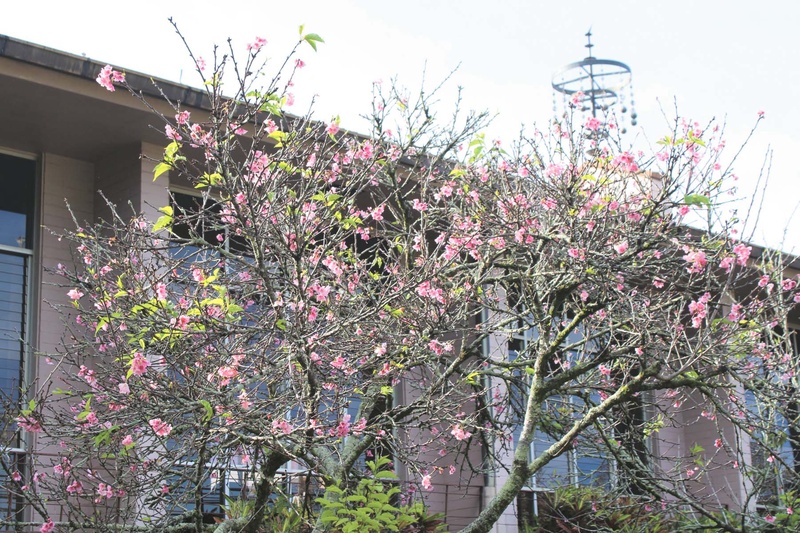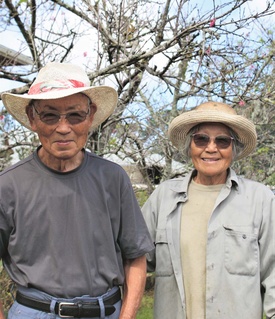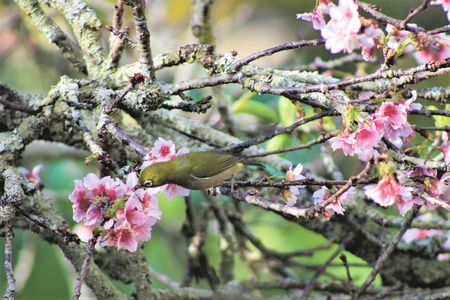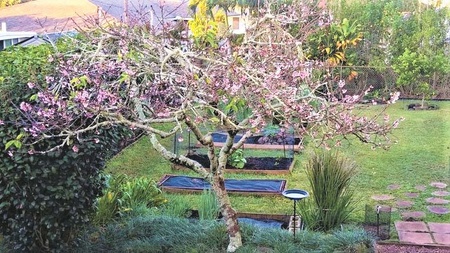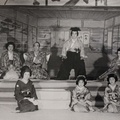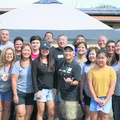I vividly recalled a chilly spring day in Shinjuku, Tökyö, back in 2013. It was a feast for the senses wandering through a park with trees flushed with sakura (cherry blossoms). Sakura is symbolic of spring in Japan, and it was at the peak of its bloom. The sights and sounds provided an immersive backdrop for a cultural encounter. It was a festive affair with families and friends sitting under sakura trees in a spectacular setting. I was envious of the people grilling yakitori and enjoying sake and bento lunches. They were celebrating hanami, “watching blossoms,” a time-honored tradition that can be traced back over a thousand years.
Over 3,800 miles away, sakura trees are flourishing in the small town of Wahiawā in the uplands of central O‘ahu. The tree varieties differ from those found in mainland Japan and the seasonal bloom may not be as spectacular. Yet, our infatuation with the beautiful sakura will draw people to Wahiawā. And for the romantic at heart, the experience may feel like a daydream of springtime in Japan.
The First Cherry Trees of Wahiawā
In Okinawa, sakura is called kanhizakura. The first kanhizakura trees were brought from Okinawa to Waipio Acres just outside Wahiawā in the early 1950s by Choro Nakasone (no relation to author). Choro gifted the seedling to his friend Tasuke Terao who longed to see sakura bloom in Japan but could not travel there during springtime.
After Tasuke and Choro planted and took care of the flourishing sakura trees, word-of-mouth quickly spread and it did not take long for cars and even a full-sized tour bus to line up in Choro’s long driveway. Sakura in Hawai‘i was new and the novelty captured people’s imagination. The people came to see his eight blooming trees set in a garden with a koi pond and his bonsai collection.
His daughter Gerrie Nakasone Nakamura said she was in her high school years in the 1960s and her father would drive her to Kilani Bakery in Wahiawā to buy pastries. She would also brew coffee for the people who came to their home.
Choro shared information on the trees and people would ask if seedlings were available. Choro propagated seedlings and donated them to the Wahiawā Okinawa Kyu Yu Kai, Jikoen Hongwanji and to friends in Wahiawā.
Gerrie said they would often defrost their older refrigerator and she would spread the ice at the base of the trees to prompt a full bloom. Sakura needs a string of chilly weather for the tree to flush.
I’m fortunate to have a descendant of Choro’s tree in my yard that’s nearly a half-century-old. A professor friend from the University of Hawai‘i, Dr. Tessie Amore, sent a photo of blossoms from my tree to Dr. Kenji Uesato, emeritus professor from the University of the Ryukyus. He wrote in an email that there are many varieties of kanhizakura in Okinawa that vary in shape and color. He noted that the blossom from my tree is not a normal type in shape and that it’s a special flower.
“My father was very proud of his Uchinanchu (Okinawan) heritage,” said Gerrie. “The sakura was a way of sharing his heritage with our community.” Those of us who have trees and all who come to see sakura in Wahiawā, owe Choro a debt of gratitude for his extraordinary gift.
Johnny Appleseed of Sakura Trees in Wahiawā
Gerrie credits Tasuke, his daughter, and son in-law, Kazue, and Hirotaka “Jack” Tsujihara for the majority of the trees we see in Wahiawā today. She called Tasuke the Johnny Appleseed of sakura trees in Wahiawā and rightfully so. He started to propagate seedlings and gave them away to Wahiawā residents willing to plant a tree in their front yard. Tasuke had a dream of making Wahiawā known for sakura.
“My father asked me to continue his dream,” said Kazue. Between them hundreds of seedlings have been given out or sold. Kazue is in her late seventies and Jack in his early eighties, and they continue to propagate seedlings today.
Kazue said this year’s bloom was the worst and Jack followed saying last year was one of the better years. He said it used to be consistent and very predictable. Their home, fronted by sakura trees, is a destination for people wanting to see sakura in Wahiawā. We were standing next to the trees and two cars stopped and the people asked: “Are we early or late?”
In parts of Japan, the season has been getting earlier, and experts say it could be due to global warming, according to The Guardian.
The Tsujiharas shared tips on propagation: You cannot propagate by cuttings or air layers. Plants need to be germinated from seeds that fall to the ground after the flowers fade. You can collect seeds, which are dark red, and plant them and less than 10 out of 100 will germinate. And it takes Zen-like patience for it can take up to 10 months for seeds to germinate. They manage to germinate 20-30 seedlings a year and not all will survive. Every seedling that survives and thrives in someone’s yard is cause for celebration.
They were dedicated to a dream and gave countless hours that were not always rewarded. They persisted and through their generosity helped to make Tasuke’s dream come true.
Sakura Safari
The Wahiawā Nikkei Civic Association in partnership with the United Japanese Society of Hawaii held annual “Hana Mi” tours led by then WNCA President Masao Wakatake. Members would caravan around Wahiawā viewing sakura and end at Tasuke’s garage to enjoy sake and bento lunches.
The popularity grew, and in 2004, Ann Kobayashi and Rene Mansho scheduled Waikiki Trolleys for an annual “Sakura Safari” tour. The largest tour was in 2018 with 480 participants and yearly averages are 120 to 360.
I was born and raised in Wahiawā, and I am the owner of sakura trees. Why would I go on a sakura tour? That snobbish attitude morphed into one of anticipation once I signed on for the tour.
Tour participants met at the Wahiawā Ryusenji Soto Mission on Saturday, Jan. 28 and were treated to Waffle Dogs prepared by student volunteers from Leilehua High School’s Leadership Club. They were under the supervision of the amicable Dayton Asato, proprietor of KC Waffle Dogs.
The 9 a.m. and 11 a.m. tours were available at $25 per participant with two trolleys that seat 60 people total per tour. I took one of the 9 a.m. tours, the first since 2020 when the pandemic hit. I was joined by 49 people from across O‘ahu on my maiden 90-minute tour. The 11 a.m. tour was sold out.
WNCA president and Wahiawā native, Mike Miyahira, provided an informative narrative with local insight for my trolley. He said according to WNCA’s best “guesstimate” there are roughly 500 trees planted throughout Wahiawā. Ninety to 95% of the trees are of Okinawan origin according to an article published by Hawai‘i Public Radio.
The trolley took us through Wahiawā neighborhoods spotting sakura in residents’ yards while Mike shared information on sakura as well as on historic landmarks and favorite old-time businesses. “The year’s bloom is not as good as other years,” said Mike. “We are at the whim of Mother Nature.” Regardless, I enjoyed the tour and would recommend it to others, including Wahiawā folks like me.
After the tour I sat down with Marie Abacayo of Mililani and Carol Duckworth of Wahiawā who were on the other trolley led by Rene. This was Marie’s fourth tour and the first for Carol. Marie said, “I love the tour because Rene Mansho is such an informative guide with an upbeat personality.” We drove through Carol’s neighborhood, and she said she was unaware of her neighbors’ sakura trees but would be on the lookout in the future.
I also spoke with Dr. William McKenzie who now resides in Mokulē‘ia on the North Shore. Dr. McKenzie was practicing in Texas when he was recruited by Wahiawā General Hospital in 1979. He helped to deliver over 9,000 babies according to his daughter Jeni McKenzie. She and Dr. McKenzie’s granddaughter, Elsabella Leguizamon, a freshman at Mililani High School, joined him on the tour.
Dr. McKenzie is a horticulture enthusiast and read about sakura in Wahiawā and wanted to learn more. Jeni attended Trinity Lutheran School in Wahiawā and now lives in Mililani. She loved reliving fond memories of the places and things she enjoyed while growing up in Wahiawā. Elsabella moved to Mililani a year ago from Los Angeles. She had this to say of the tour, “it was long but in a good way. It was calming, and I never saw sakura until today.”
“We love to go on family outings,” said Jeni. “So we decided to take the tour together.” And we all agreed with Dr. McKenzie when he said, “it was nice. People along the way all smiled and waved. It’s so Wahiawā.”
*This article was originally published in the Hawai'i Herald on March 17, 2023.
© 2023 Dan Nakasone / The Hawai'i Herald


